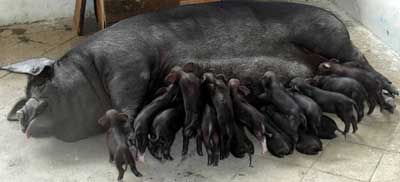GENETIC RESOURCES OF PIGS IN INDIA
Bhabesh Mili1 and Prasanta Boro2
1Assistant Professor, Department of Veterinary Physiology and Biochemistry , College of Veterinary Sciences and Animal Husbandry, Central Agricultural University (I), Jalukie, Peren, Nagaland-797110.
2Junior Scientist, Livestock Research Station, Assam Agricultural University, Mandira, Hekra, Kamrup, Assam, India.
E-mail: prasanta.boro@aau.ac.in
Pigs play a vital role in providing livelihood, food, and nutritional security to billions of people across the world. A profitable pig production largely depended on two factors viz genetics and environment. The genetics of a pig plays an important role in its performance and meat quality. At present, there are 137 recognized pig breeds in the world. This genetic diversity within and among populations in relation to breeds is developed as a result of the interaction between animals and the environment for survivability in their ecological niches. The genetic diversity appears according to the requirements of the environment, their production system, and their personal preferences or breeding goals which is reflected in their phenotype in terms of productivity performances and adaptability. Each pig breed has unique useful genes for growth, production, disease resistance including adaptive capacity, etc. Unfortunately, very little work has been done to identify such utility genes and breeds for conservation in India. The knowledge of all breeds is a prerequisite for proper utilization especially for the development of large litter size, better feed conversion efficiency, high dressing percentage, and quality pork-producing pig as well as genetic selection for profitable pig farmers cum enterprises in the present context of changing global climate change scenario.
India’s pig population is 9.06 million (20th Livestock Census, 2019), against the world population of about 900 million (FAOSTAT Databases 2020). About 79.03% of the total pig population is of indigenous & nondescript pigs (20th Livestock Census, 2019). The indigenous pigs are distributed throughout the country with different morphometric traits and production parameters. These pigs are smaller in size, but well adapted to hot and humid climates and have relatively better disease tolerance compared to crossbreds and exotic breeds. Some of these native pigs are mature at an exceptionally early age, and also possess good mothering ability, which directly influences the survivability of their piglets during younger age. Further, the indigenous pigs are well-preferred by the consumers due to quality and taste of pork over the exotic and crossbred pigs in some regions of the country. Therefore, selecting a good breed matters a lot in this enterprise because this leads to giving birth to healthy piglets and the eventual growth of the business.
Pig breed of India
There are 10 registered indigenous pig breeds in India. Indigenous pigs are small in size, pot-bellied with an elongated face and short ears. The indigenous pig breeds are as follows:-
- Ghungroo
Ghungroo is the first recognized pig breed of India (Accession No: INDIA_PIG_2100_ GHOONGROO_09001). This pig is found in North Bengal and the adjoining district of Assam. Ghungroo pigs are mostly black coloured, long tail, upwardly curved snout, large heart-shaped ears, with folded skin on face and neck, long and cylindrical barrel belly with a typical Bulldog face. This pig has unique traits like high prolificacy with a litter size of 6-10 piglets, individually weighing about 0.89-1.1 kg at birth and can be reared in a low input production system (Boro et al. 2021). The adult body is weighing about 55 to 60 kg. The female pigs attain sexual maturity at 10 months and in males as early as 8 months. The gestation period is about 112-115 days (Boro et al. 2021).
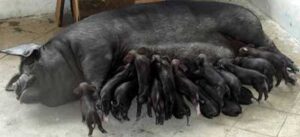
Fig.1: Ghungroo pig
- Niang Megha
Niang Megha is a medium-sized pig breed (Accession No: INDIA_PIG_1300_NIANGMEGHA_09002) found in the Garo, Khasi, and Jaintia hills of Meghalaya. The body coat colour is black with white patches on the forehead and legs with erect bristles on the dorsal midline. The adult body weight ranges between 50 to 60 kg. The averages litter size at birth, litter size at weaning, litter weight at birth, litter weight at weaning, age at first estrus, age at the first fertile service, age at first farrowing, farrowing interval and the gestation period is 6.080 ± 0.219, 5.202 ± 0.190, 3.172 ± 0.107 kg, 30.614 ± 1.199 kg, 221.173 ± 1.527 days, 246.440 ± 1.385 days, 347.813 ± 3.516 days, 206.121 ± 0.785 days and 111.848 ± 0.136 days respectively (Khargharia et al. 2014).
- Agonda Goan
Agonda Goan is a pig breed (Accession No: INDIA_PIG_3500_ AGONDAGOAN _09003) found in the Agonda region of Goa. This pig is traditionally known as ‘Gavthi Dukor’ in Goa. This pig is mostly black coloured some time white patches on legs and face are found. The pigs have a short snout with short erect ears. The average adult body weight is 40 kg. The unique trait of Agonda Goan pig is good mothering ability and lean meat with high palatability. The average age at the first farrowing and farrowing interval is 195 ± 4.78 days (Chakurkar et al. 2021).
- Tanyi-vo
Tenyi-vo pig is a registered pig breed (Accession No.: INDIA_PIG_1400_TENYI-VO_09004) native to the state of Nagaland. This indigenous pig has unique traits like well adaptability to its own ecological niche, relatively high disease resistance, can be reared with zero grain production system, in the backyard with household kitchen waste, garbage crop residues, attain early sexual maturity, low feed intake capacity, excellent mothering ability and good meat quality (Rutsa and Rutsa, 2019). The body coat is predominantly jet black with white markings on the forehead, flanks, switch of the tail and legs. The pig has moderately dense coat and small and erects ears. The adult body weight ranges between 40 to 60 kg at maturity. The female pigs attain sexual maturity as early as 150 days (Average 180days) and in males as early as 90 days. The gestation period is 109-116 days and usually farrow 4-6 piglets (Rutsa and Rutsa, 2019).
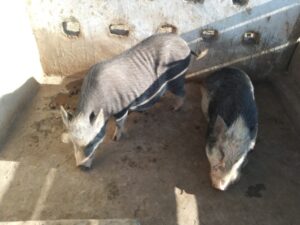
Fig. 2: Tenyi-vo pigs
- Nicobari
Nicobari is a pig breed (accession No. of the breed is INDIA_PIG_3300_ NICOBARI _09005) found in Car Nicobar and adjoining islands of Andaman and Nicobar. This pig is locally known as Ha-un, is linked closely with the local culture and tradition. The pigs are short to medium in size with an active look. The coat colour of the pigs varies from mostly black to red-brown, brown, grey, and fawn. Nicobari pigs are semi-feral in nature. These pigs are generally raised mostly in the free range and by the tribes. The average adult body weight is 45-55 kg. The average age at first farrowing, litter size and the farrowing interval is 10 to 12 months, 6 to 10, and 8-10 months respectively.
![]()
Fig.3: Niconari female pigs
- Doom
The Doom pig is the only registered pig breed of Assam (Accession No INDIA_PIG_0200_ DOOM _09006). This pig is well known for quality meat and bristle. The coat colour is predominantly black with a white patch on the forehead. The pig has a thick bristle in the mid-dorsal line. The average adult body weight of doom pig is about 35 to 45 kg. The average age at first estrus, age at first fertile service, age at first farrowing, gestation length, and inter farrowing period is 213.91±1.36, 237.95±1.18, 351.51±1.24, 113.51±0.40, and 213.25±1.45 days respectively (Rahman et al. 2020). The average litter size at birth, litter size at weaning, litter weight at birth, and litter weight at weaning is 5.55 ± 0.11, 4.56 ± 0.09, 3.38 ± 0.06 kg and38.75 ± 0.55 kg respectively (Rahman et al. 2020).
- Zovawk
Zovawk pig is a registered pig breed (Accession No.: INDIA_PIG_2700_ ZOVAWK _09007), native to the state of Mizoram. This pig is relatively high resistance to diseases and survives well in remote areas where no adequate disease prevention and therapeutic measures are available (Zosangpuii et al. 2020). The body coat is predominantly black with a star on the forehead and white hairs in four limbs below the knee region. The adult body weight ranges between 40 to 50 kg at maturity. The female pigs attain sexual maturity at 120±1.18 days and 143.20±1.44 days in males. The gestation period is 114.77±0.27 days and usually farrow 5-8 piglets. The average age at first farrowing is 314.9±5.8 days (Zosangpuii et al. 2020).
- Gurrah
Gurrah pig is (accession No. of the breed is INDIA_PIG_2000_GHURRAH_09008) native to Bareilly division and adjoining pats of Lucknow division of Uttar Pradesh. They are predominately black with a white stripe below the hock joint. Gurrah pigs are medium in size with an angular body and long straight snout with a flat belly. The adult male body weighs is about 46kg and the female is about 48kg. There is a thick line of hairs is present from neck to shoulders. Head is elongated with triangular face and short leaf shaped vertically erected ears. The average litter size is 6.85 at birth and 5.65 at weaning.
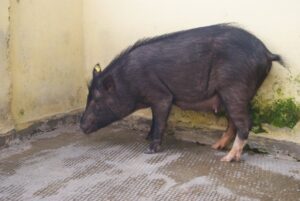
Fig.4: Gurrah female pigs.
- Mali
Mali is an indigenous pig breed (Accession No: INDIA_PIG_1900_MALI_09009) native to Tripura. They are medium-sized with an adult body weight of about 68 kg in males and 71 kg in females. The pig is predominately black coat colour and has no specific distinct marking. However, a medium to a small bristle is ubiquitously distributed throughout the body. The average litter size is 5.15 (range 3-7) at birth and 4.46 (range 3-6) at weaning age. The female pigs attain puberty at 117.9±1.5 days and 138.3±6.4 days in males. The average age at first farrowing is about 281.4±1.6 days (Dandapat et al. 2010).
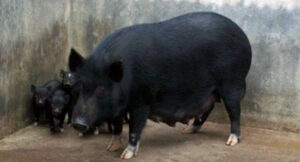
Fig.5: Mali female pigs
- Purnea Local
Purnea Local pig breed (accession No. of the breed is INDIA_PIG_0325_ PURNEA_09010) is native to the Purnea and Araria districts of Bihar but is also found in other parts of Bihar and some parts of Jharkhand. They are medium-sized with an adult body weight of about 44 kg in males and 42kg in females. Purnea Local pigs are predominately black colored with potbelly but there is no specific distinct marking. However, in a few pigs, a white spot at the lower limb is also seen. The thick line of bristle is present from neck to shoulders. These pigs are characterized by round faces, short erect ears with a slightly concave snout. The average litter size is 5.02 at birth and 4.97 at weaning.
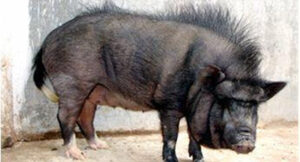
Fig.6: Purnea local female pigs.
Indian crossbred pig varieties
The indigenous pigs are smaller in body size with less litter size per cropping. Various efforts are being undertaken by the Central and State Departments; especially different Research Organizations like ICAR, CAU, SVUs/SAUs for genetic improvement of indigenous pigs based on farmer’s choice and suitable for commercial piggery farming. Subsequently, crossbreeding of indigenous pigs with the exotic boars resulted in the development of nine crossbred pig varieties suitable for the different agro-climatic conditions of the country. The crossbred pig varieties are as follows:-
| Sl. No | Name of the crossbred pig varieties | Characteristics | Name of the developing organization/ institute |
| 1 | Rani
This pig variety has 50% Hampshire (exotic breed) and 50% Ghungroo (indigenous breed) inheritance. |
This pig gains almost 75 kg body weight at slaughter age of 8 months with 1.98 cm of backfat thickness. | ICAR– National Research Centre on Pig, Guwahati, Assam |
| 2 | Asha
This pig variety has 25% Ghungroo, 25% Hampshire (exotic breed) and 50% Duroc (exotic breed) inheritance. |
This pig variety can produce 80 kg lean pork at slaughter age of 8 months with 1.75 cm backfat thickness. | ICAR – National Research Centre on Pig, Guwahati, Assam. |
| 3 | HD-K75
This pig variety has 75% Hampshire (exotic breed) inheritance and 25% indigenous inheritance of local pigs of Assam. |
This pig variety attains almost 74 – 80 kg body weight at slaughter age of 8 months with 1.75- 2.58 cm of backfat thickness.
|
All India Coordinated Research project on Pig, Assam Agricultural University at Khanapara, Guwahati, Assam |
| 4 | Jharsuk
This pig variety has 50 % Tamworth (exotic breed) and 50 % local pigs of Jharkhand inheritances. |
This pig variety attains approximately 80 kg body weight at slaughter age of 8-10 months. It can produce 8-12 piglets in each farrowing with two farrowing each year. | All India Coordinated Research Project on Pig at Birsa Agricultural University, Ranchi.
|
| 5 | Mannuthy White
This pig variety has 75 % Large White Yorkshire (Exotic) and 25 % Desi (Local) pig of Kerala inheritance. |
The crossbred pig variety attains 94 kg bodyweight at slaughter age of 10 months and 2.10 cm of backfat thickness.
|
All India Coordinated Research Project on Pig at Kerala Veterinary and Animal Sciences University, Mannuthy, Kerala |
| 6 | Lumsniang
This crossbred pig variety has Hampshire (Exotic) and Niang Megha pig of Meghalaya inheritance. |
The pig variety attained a higher body weight of 90-100 kg at 12 months of age, besides higher litter size at weaning as compared to local non-descriptive pigs’ (8.56±0.77 Vs 5.23±0.54). | All India Coordinated Research Project on Pig at ICAR-Research Complex for NEH Region, Barapani |
| 7 | TANUVAS KPM Gold This pig variety has 75 % Large White Yorkshire (Exotic) and 25% Desi pig of Tamil Nadu inheritance. | The pig variety attains 72 kg body weight at 8 months with 8.09 litter size at birth. | All India Coordinated Research Project on Pig at PGRIAS, Kattupakkam |
| 8 | SVVU-T17
This pig variety has 75 % Large White Yorkshire (exotic breed) and 25 % Desi pig of Andhra Pradesh inheritance. |
This pig variety attains 85.48 kg body weight at slaughter age of 10 months with 8.1 litter size at birth. | All India Coordinated Research Project on Pig centre of Sri Venkateswara Veterinary University (SVVU), Tirupati |
| 9 | Landlly
This pig variety has 75 % Landrace (exotic) with 25 % Gurrah pig (local) inheritance. |
This pig verity attains marketable weight at the age of 8 months. | AICRP on Pig centre of ICAR-Indian Veterinary Research Institute (IVRI), Bareilly |
Conclusion
India is richly endowed with a variety of indigenous pig germplasm majority of which are yet to be characterize. These pigs have unique characteristics such as being well adapted to hot and humid climates and having relatively better disease tolerance compared to exotic breeds. Many of the indigenous pig breeds may already be facing the threat of endangerment because of indiscriminate crossbreeding practices. Therefore, utmost care needs to be taken while crossbreeding for the genetic improvement of indigenous pigs based on farmer’s choice and suitable for commercial piggery farming for the holistic development of the sector. At the same time, there is an urgent need of systemically survey, documentation, characterization and conservation of indigenous pigs of India.
References:
Boro P, Bharali D, Sarma M, Sonowal M, Saharia J, Brahma J, Kalita MC and Thakuria J (2021). Performances of Ghungroo pigs reared under farm condition. Journal of Entomology and Zoology Studies 9(1): 2265-2267.
Chakurkar Eaknath B. & Amiya Ranjan Sahu & Sajan Naik & Chethan Kumar H.B. and Gokuldas P.P. (2021) Genetic evaluation of growth and reproductive performances of crossbred pigs reared under intensive system in tropical humid coastal climate. Tropical Animal Health and Production 53:243.
Dandapat A, Choudhury D, Debbarma KB, Das MK (2010). Phenotypic characterization of Mali pig in Tripura, India. Livestock Research for Rural Development. 22(4):1-4.
FAOSTAT Databases. 2020. Available from: URL: http:// faostat.fao.org/. (Accessed in September 2020).
Indian Livestock Census. 2019. Animal Husbandry Statistics Division, Department of Animal Husbandry Dairying and Fisheries, Ministry of Agriculture, Government of India.
Khargharia, G., Zaman, G., Laskar, S., Das, B., Aziz, A., Roychoudhury, R. and Roy, T. C. (2014) Phenotypic Characterization And Performance Studies Of Niang Megha And Doom Pigs Of North Eastern India. Asian Academic Research Journal of Multidisciplinary, 1 (27):-667-676.
Rahman, M., Phookan, A., Zaman, Galib Uz., Das, A., Akhtar, F., Hussain, J and Choudhury H (2020) Growth and Reproductive Performances of Doom Pigs Under Field Condition. Veterinary Research International, 08 (02): 73-77.
Rutsa, M C and Rutsa V (2019) Characterization of population and production system of Tenyi-vo pig of Nagaland (India). Journal of Livestock Biodiversity, 9: 5-8.
Zosangpuii, J B Rajesh, H Lalliankimi, L Hmar, NS Singh and Elizabeth L Leihang. (2020) Phenotypic characterization of local pigs (Zovawk) in Mizoram. Journal of Entomology and Zoology Studies 8(5): 336-338.
***
https://nbagr.icar.gov.in/en/registered-pig/


